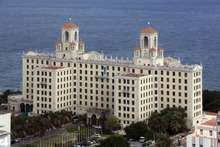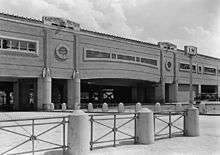Lawrence Grant White
Lawrence Grant White (September 26, 1887 – September 8, 1956) was an American architect, a partner in the architectural firm of McKim, Mead & White, co-founded by his father Stanford White, and for five years the president of the National Academy of Design.[1]
Lawrence Grant White | |
|---|---|
| Born | September 26, 1887 |
| Died | September 8, 1956 (aged 68) |
| Education | Harvard University École des Beaux-Arts |
| Spouse(s) | Laura Astor Chanler
( m. 1916; |
| Children | Eight, including: Robert Winthrop White |
| Parent(s) | Stanford White Bessie Springs Smith |
| Relatives | Richard Grant White (grandfather) |
| Awards | Legion of Honour |
Early life
Lawrence White, who was known as Larry, was born in New York City in 1887, the only surviving child of renowned architect Stanford White (1853–1906) and Elizabeth "Bessie" Springs (née Smith) White (1862–1950). His only sibling, an elder brother who died in infancy in 1885, was named after his paternal grandfather Richard Grant White, a Shakespearean scholar, husband of Alexina Black (née Mease) White.[2] Larry White's maternal grandparents were John Lawrence Smith (1816–1889) and Sarah Nicoll (née Clinch) Smith (1823–1890), members of the family after which Smithtown is named.[3] An uncle, James Clinch Smith, died aboard the RMS Titanic in 1912.[4][5][6]
White grew up at Box Hill, a farmhouse converted to an Italianate mansion by his architect father, situated on his parent's 60-acre Long Island estate.[7][8] In 1906, when he was almost 20 years old, his father was shot and killed by Harry K. Thaw over the father's affair with Thaw's wife, Evelyn Nesbit.[1][9]
Career

In 1908, White earned an A.B. degree cum laude from Harvard University, and in 1913, he received a diploma from the École des Beaux-Arts in Paris.[10] From 1915 until 1917, he worked at McKim, Mead & White (as did his Harvard classmate and fellow architect Frederic Rhinelander King).[11]
McKim, Mead & White

In 1919, after serving in the navy during World War I, he re-joined the architectural firm of McKim, Mead & White, co-founded in 1879 by his late father with William Rutherford Mead and Charles Follen McKim.[12]
At McKim, Mead & White, he worked closely with William Mitchell Kendall. He designed the Hotel Nacional in Havana, Cuba, and the (since destroyed) Savoy-Plaza Hotel on Fifth Avenue in New York.[13] He also designed the Pennsylvania Railroad Station in Newark, 52 Wall Street, the Regimental Barracks on Governors Island, and the Girard Trust Company offices in Philadelphia.[1]
Chanler was a social acquaintance of Mildred Barnes Bliss and Robert Woods Bliss who were friends with Edith Wharton and Margaret Chanler, his wife's mother.[10] The Bliss' engaged White and the firm to design the buildings of the Service Group at Dumbarton Oaks as well as the Music Room and the East Bay of the living room.[10][14]
White served as the president of the National Academy of Design for five years and a trustee of the Metropolitan Museum of Art shortly before his death.[1][15] According to The New York Times, White was "a renaissance man" who "wrote light verse, painted, played the piano and published a translation of Dante's Inferno."[7] In fact in 1948 he published a translation of Dante's entire Divine Comedy.[16]
Personal life
On June 19, 1916,[17] Larry White married Laura Astor Chanler (1887–1984),[18] the eldest child of Winthrop Astor Chanler and Margaret Louisa (née Terry) Chanler;[19] a descendant of the Ward, Astor, Dudley–Winthrop, Livingston and Stuyvesant families;[20] and a painter and sculptor who trained at the Académie Julian in Paris. Together, they raised eight children at Box Hill:[7]
- F. L. Peter White (1917–2009), who married Jehanne Price in 1943.[21]
- Elizabeth Stuyvesant White (1920–2011), a Roman Catholic nun.
- Robert Winthrop White (1921–2002), a sculptor who married Claire Nicolas (1925–2020), a poet and niece of Aldous Huxley.[13]
- Alida Mary White (b. ca. 1922), who married (1st) in 1943 the composer John Lessard (1920–2003),[22][23] and after their divorce, married (2nd) in 1996 Montgomery Hare (1911–1998).[24]
- John Chanler White (1924–1989), who married in 1968 Claire Raiguel McAllister, the daughter of Judge Thomas Francis McAllister.[25]
- Cynthia Margaret White (b. ca. 1927), who married Robert Dean Jay (1921–1998).[26]
- Sarah M. White (b. ca. 1929), a Roman Catholic nun.
- Ann Octavia White (b. ca. 1932), an architect who married in 1955 Harold Buttrick (1931–2015), co-founder of the architecture firm Buttrick White & Burtis.[13][27][28]
Larry White died on September 8, 1956 at his home in St. James, New York.[1] He was buried at Saint James Episcopal Church graveyard in St. James.
Descendants
Lawrence Grant White has many descendants, including Genevieve White Carter, an interior designer.[13][29]
References
- "L.G. White Dead; Architect Was 68; Senior Partner of McKim, Mead & White Had Headed Academy of Design". The New York Times. 9 September 1956. Retrieved 21 February 2018.
- White, Stanford (1997). Stanford White: Letters to His Family : Including a Selection of Letters to Augustus Saint-Gaudens. Random House Incorporated. pp. 5, 9, 18. ISBN 9780847820221. Retrieved 22 February 2018.
- Broderick, Mosette (2010). Triumvirate: McKim, Mead & White: Art, Architecture, Scandal, and Class in America's Gilded Age. Knopf Doubleday Publishing Group. p. 257. ISBN 9780307594273. Retrieved 22 February 2018.
- Smith, George Stuart (24 April 1912). "The Loss of James Clinch Smith". The New York Times. Retrieved 22 February 2018.
- "Titanic Carried 1,320 Passengers; Had 325 in Her First, 285 in the Second, and 710 in Her Third Cabin". The New York Times. 16 April 1912. Retrieved 22 February 2018.
- Mr. James Clinch Smith; Encyclopedia-Titanica.org
- Giovannini, Joseph (18 August 1983). "A Legacy of Talent at the Stanford White Estate". The New York Times. Retrieved 22 February 2018.
- Harrison, Helen A., Art Review: "Creative Lines, Haunted by Scandal," The New York Times, November 28, 2004, retrieved February 22, 2018.
- Fleming, Geoffrey K. (2006). St. James. Arcadia Publishing. p. 30. ISBN 9780738546100. Retrieved 22 February 2018.
- Taylor, Sara. "Lawrence Grant White (1887–1956)". www.doaks.org. Dumbarton Oaks Research Library and Collection. Retrieved 22 February 2018.
- "Frederic King, 84, Architect MEAD". New York Times. 22 March 1972. Retrieved 1 May 2017.
- Gearty, Robert (July 26, 1998). "Exhibition Shines Light on Architecture by White". New York Daily News. Retrieved 22 February 2018.
- Shirinian, Natalie (21 October 2015). "Stanford White's Legacy Lives On With Great-Great Granddaughter Genevieve White Carter". Huffington Post. Retrieved 22 February 2018.
- James N. Carder, "The Architectural History of Dumbarton Oaks and the Contribution of Armand Albert Rateau," in A Home of the Humanities: The Collecting and Patronage of Mildred and Robert Woods Bliss, ed. James N. Carder (Washington, D.C.: Dumbarton Oaks Research Library and Collection, 2010), pps. 92–115.
- "Noted Architect Elected Trustee of Art Museum". The New York Times. 22 May 1956. Retrieved 22 February 2018.
- White, Lawrence Grant (1948). The Divine comedy: the Inferno, Purgatorio, and Paradiso; a new translation into English blank verse by Lawrence Grant White, with illustrations by Gustave Doré. New York: Pantheon Books.
- "L. G. White to Wed Artist. Son of Late Architect Engaged to Miss Laura Chanler". The New York Times. 27 April 1916. Retrieved 22 February 2018.
- "White-Chanler Wedding; Architect, Son of the Late Stanford White, Marries Sculptress". The New York Times. 20 June 1916. Retrieved 22 February 2018.
- "Major Chanler Stricken; Master of Genesee Valley Hunt Has Stroke After a Fall From Horse". The New York Times. 6 August 1926. Retrieved 21 February 2018.
- Jacob, Kathryn Allamong (2010). King of the Lobby: The Life and Times of Sam Ward, Man-About-Washington in the Gilded Age. JHU Press. ISBN 9780801893971. Retrieved 7 February 2017.
- Obituary, The New York Times, February 5, 2009.
- Lessard, Suzannah (1996). The Architect of Desire: Beauty and Danger in the Stanford White Family. The Dial Press. ISBN 978-0385314459.
- "Miss Alida White Becomes a Bride; Married to John A. Lessard of Army in Church of SS. Philip and James in St. James, L.I. – Wears Heirloom Veil – Miss Cynthia M. White Maid of Honor for Sister – John C. White Is Best Man". The New York Times. 23 May 1943. Retrieved 22 February 2018.
- "Paid Notice: Deaths Hare, Montgomery". The New York Times. 1 April 1998. Retrieved 22 February 2018.
- "Miss McAllister, John White Wed". The New York Times. 13 April 1968. Retrieved 22 February 2018.
- "Paid Notice: Deaths Jay, Robert Dean". The New York Times. 2 July 1998. Retrieved 22 February 2018.
- "Paid Notice: Deaths Buttrick, Harold Edgar". The New York Times. 18 February 2015. Retrieved 22 February 2018.
- "Miss Ann O. White Becomes a Bride; Married in St. James, L.I., to Harold Buttrick, Student of Design at Harvard". The New York Times. 4 September 1955. Retrieved 22 February 2018.
- Lessard, Suzannah (1 July 1996). "Stanford White's Ruins". The New Yorker. Retrieved 22 February 2018.